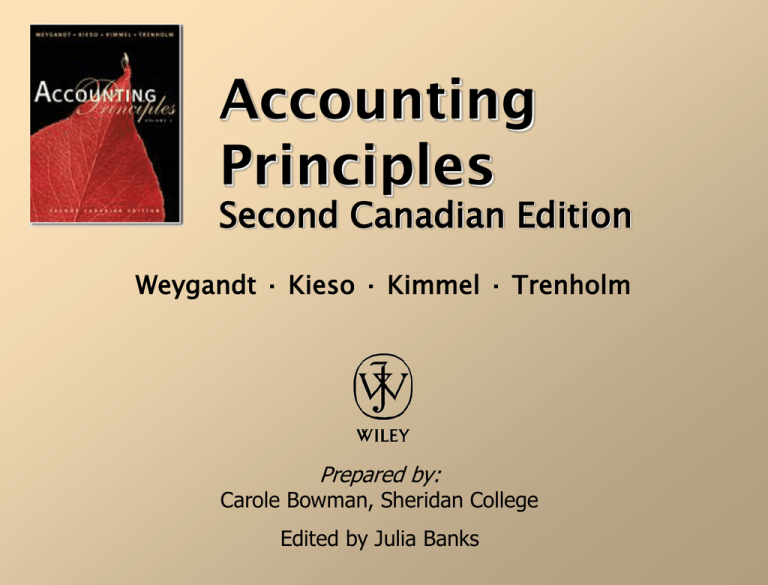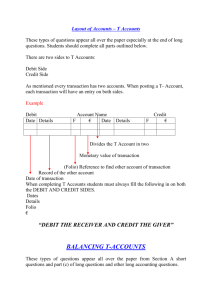
Accounting
Principles
Second Canadian Edition
Weygandt · Kieso · Kimmel · Trenholm
Prepared by:
Carole Bowman, Sheridan College
Edited by Julia Banks
CHAPTER
2
THE RECORDING PROCESS
THE ACCOUNT
An
account is an individual record of
increases and decreases in a specific asset,
liability, or owner’s equity item.
A company will have separate accounts for
such items as cash, salaries expense,
accounts payable, and so on.
BASIC ACCOUNTING EQUATION
Debit and Credit Theory
Assets
DR
CR
=
Liabilities
DR
CR
+
Owner’s Equity
DR
CR
DEBITS AND CREDITS
The terms debit and credit mean left and right,
respectively.
The act of entering an amount on the left side of an
account is called debiting the account and making an
entry on the right side is crediting the account.
When the debit amounts exceed the credits, an account
has a debit balance; when the reverse is true, the account
has a credit balance.
Title of Account
Left or debit side
Right or credit side
Debit balance
Credit balance
ILLUSTRATION 2-1
BASIC FORM OF ACCOUNT
In its simplest form, an account consists of
1. the title of the account,
2. a left or debit side, and
3. a right or credit side.
The alignment of these parts resembles the letter T, and
therefore the account form is called a T account.
Title of Account
Left or debit side
Right or credit side
Debit balance
Credit balance
ILLUSTRATION 2-2
TABULAR SUMMARY COMPARED TO
ACCOUNT FORM
Tabular Summary
Account Form
Cash
$15,000
- 7,000
1,200
1,500
- 600
- 900
- 200
- 250
600
- 1,300
Cash
$8,050
Debit
15,000
1,200
1,500
600
Balance
8,05
0
Credit
7,000
600
900
200
250
1,300
DEBITING AN ACCOUNT
Cash
15,000
DR.
CR
Banks, Capital
15, 000
Example: The owner makes an initial investment of
$15,000 to start the business. Cash is debited
and the owner’s Capital account is credited.
CREDITING AN ACCOUNT
DR.
Cash
CR
7,000
Rent Expense
7,000
Example: Monthly rent of $7,000 is paid. Cash is
credited and Rent Expense is debited.
DEBITING AND CREDITING
AN ACCOUNT
Cash
15,000
8,000
7,000
Example: Cash is debited for $15,000 and credited for
$7,000, leaving a debit balance of $8,000.
DOUBLE-ENTRY SYSTEM
In a double-entry system, equal debits and credits are
made in the accounts for each transaction.
Thus, the total debits will always equal the total credits
and the accounting equation will always stay in balance.
Total Dr’s = Total Cr’s for every transaction
Assets
Liabilities
Equity
NORMAL BALANCE
Every account classification has a normal
balance, whether it is a debit or credit.
ILLUSTRATION 2-3
NORMAL BALANCES — ASSETS AND LIABILITIES
Assets
Increase
Debit
Decrease
Credit
Normal
Balance
Liabilities
Decrease
Debit
Increase
Credit
Normal
Balance
ILLUSTRATION 2-4
NORMAL BALANCE — OWNER’S CAPITAL
Owner’s Capital
Decrease
Debit
Increase
Credit
Normal
Balance
ILLUSTRATION 2-5
NORMAL BALANCE — OWNER’S DRAWINGS
Owner’s Drawings
Increase
Debit
Normal
Balance
Decrease
Credit
ILLUSTRATION 2-6
NORMAL BALANCES —
REVENUES AND EXPENSES
Revenues
Decrease Increase
Debit
Credit
Normal
Balance
Expenses
Increase
Debit
Normal
Balance
Decrease
Credit
ILLUSTRATION 2-7
EXPANDED BASIC EQUATION AND
DEBIT/CREDIT RULES AND EFFECTS
Assets
Assets
Dr.
+
Cr.
-
= Liabilities
=
Liabilities
Dr.
-
Owner’s Equity
+
+
Cr.
+
Owner’s
Capital
Dr.
-
+
Cr.
+
Revenues
Dr.
-
-
Cr.
+
Owner’s
Drawings
Dr.
+
-
Cr.
-
Expenses
Dr.
+
Cr.
-
ILLUSTRATION 2-9
THE RECORDING PROCESS
JOURNAL
JOURNAL
LEDGER
1. Analyse each transaction.
2. Enter transaction in a journal.
3. Transfer journal information to ledger accounts.
THE JOURNAL
Transactions are initially recorded in
chronological order in a journal before being
transferred to the accounts.
Every company has a general journal which
contains
1. spaces for dates,
2. account titles and explanations,
3. references, and
4. two money columns.
THE JOURNAL
The journal makes several significant contributions to the
recording process:
1. It discloses, in one place, the complete effect of a
transaction.
2. It provides a chronological record of transactions.
3. It helps to prevent or locate errors because the debit and
credit amounts for each entry can be readily compared.
JOURNALIZING
Entering transaction data in the journal is known
as journalizing.
Separate journal entries are made for each
transaction.
A complete entry consists of
1. the date of the transaction,
2. the accounts and amounts to be debited and
credited, and
3. a brief explanation of the transaction.
ILLUSTRATION 2-10
TECHNIQUE OF JOURNALIZING
The date of the transaction is entered in the date column.
J1
GENERAL JOURNAL
Date
2002
Sept. 1
1
Account Titles and Explanation
Cash
M. Doucet, Capital
Invested cash in business.
Equipment
Cash
Purchased equipment for cash.
Ref.
Debit
Credit
15,000
15,000
7,000
7,000
ILLUSTRATION 2-10
TECHNIQUE OF JOURNALIZING
The debit account title is entered at the extreme left
margin of the Account Titles and Explanation column.
The credit account title is indented on the next line.
J1
GENERAL JOURNAL
Date
2002
Sept. 1
1
Account Titles and Explanation
Cash
M. Doucet, Capital
Invested cash in business.
Equipment
Cash
Purchased equipment for cash.
Ref.
Debit
Credit
15,000
15,000
7,000
7,000
ILLUSTRATION 2-10
TECHNIQUE OF JOURNALIZING
The amounts for the debits are recorded in the Debit column and
the amounts for the credits are recorded in the Credit column.
J1
GENERAL JOURNAL
Date
2002
Sept. 1
1
Account Titles and Explanation
Cash
M. Doucet, Capital
Invested cash in business.
Equipment
Cash
Purchased equipment for cash.
Ref.
Debit
Credit
15,000
15,000
7,000
7,000
ILLUSTRATION 2-10
TECHNIQUE OF JOURNALIZING
A brief explanation of the transaction is given.
J1
GENERAL JOURNAL
Date
2002
Sept. 1
1
Account Titles and Explanation
Cash
M. Doucet, Capital
Invested cash in business.
Equipment
Cash
Purchased equipment for cash.
Ref.
Debit
Credit
15,000
15,000
7,000
7,000
ILLUSTRATION 2-10
TECHNIQUE OF JOURNALIZING
A space is left between journal entries. The
blank space separates individual journal entries
and makes the journal easier to read.
J1
GENERAL JOURNAL
Date
2002
Sept. 1
1
Account Titles and Explanation
Cash
M. Doucet, Capital
Invested cash in business.
Equipment
Cash
Purchased equipment for cash.
Ref.
Debit
Credit
15,000
15,000
7,000
7,000
ILLUSTRATION 2-10
TECHNIQUE OF JOURNALIZING
The column entitled Ref. is left blank at the time the
journal entry is made and is used later when the
journal entries are transferred to the ledger accounts.
J1
GENERAL JOURNAL
Date
2002
Sept. 1
1
Account Titles and Explanation
Cash
M. Doucet, Capital
Invested cash in business.
Equipment
Cash
Purchased equipment for cash.
Ref.
Debit
Credit
15,000
15,000
7,000
7,000
SIMPLE AND COMPOUND
JOURNAL ENTRIES
If an entry involves only two accounts, one debit and
one credit, it is considered a simple entry.
J1
GENERAL JOURNAL
Date
2002
Oct. 2
Account Titles and Explanation
Delivery Equipment
Cash
Purchased truck for cash.
Ref.
Debit
Credit
14,000
14,000
ILLUSTRATION 2-11
COMPOUND JOURNAL ENTRY
When three or more accounts are required in one
journal entry, the entry is referred to as a
compound entry.
J1
GENERAL JOURNAL
Date
2002
Oct. 2
1
2
3
Account Titles and Explanation
Delivery Equipment
Cash
Note Payable
Purchased truck for cash
and note payable.
Ref.
Debit
Credit
34,000
8,000
26,000
COMPOUND JOURNAL ENTRY
This is the wrong format; all debits must be listed
before the credits are listed.
J1
GENERAL JOURNAL
Date
2002
Oct. 2
Account Titles and Explanation
Cash
Delivery Equipment
Note Payable
Purchased truck for cash
and note payable.
Ref.
Debit
Credit
8,000
34,000
26,000
THE LEDGER
The entire group of accounts maintained by a company is referred
to collectively as the ledger.
A general ledger contains all the assets, liabilities, and owner’s
equity accounts.
In computer format, think of the ledger as a folder and the history
of each individual account as an individual file in the folder.
GENERAL
LEDGER
ILLUSTRATION 2-12
THE GENERAL LEDGER
Individual
Assets
Equipment
Supplies
Accounts Rec.
Cash
Individual
Liabilities
Interest Payable
Salaries Payable
Accounts Payable
Notes Payable
Individual
Owner’s Equity
Salaries Expense
Service Revenue
Doucet, Drawings
Doucet, Capital
ILLUSTRATION 2-14
POSTING A JOURNAL ENTRY
General Journal
Account Title and Explanation
Date
2002
01-Sep Cash
M. Doucet, Capital
Invested cash in business.
Date
2002
01-Sep
Ref
101
301
General Ledger
Cash
Account Title and Explanation Ref
J1
Debit
J1
Credit
15,000
Debit
15,000
15,000
Credit
101
Balance
15,000
In the ledger, enter in the appropriate columns of the account(s)
debited the date, journal page, and debit amount shown in the journal
and the account number to which the journal was posted.
ILLUSTRATION 2-14
POSTING A JOURNAL ENTRY
General Journal
Account Title and Explanation
Date
2002
01-Sep Cash
M. Doucet, Capital
Invested cash in business.
General Ledger
M. Doucet, Capital
Date Account Title and Explanation Ref
2002
1-Sep
J1
Ref
101
301
Debit
Debit
J1
Credit
15,000
15,000
Credit
15,000
301
Balance
15,000
In the ledger, enter in the appropriate columns of the account(s)
credited the date, journal page, and credit amount shown in the
journal and the account number to which the journal was posted.
THE TRIAL BALANCE
A trial balance is a list of accounts and their balances at a
given time.
The primary purpose of a trial balance is to prove the
mathematical equality of debits and credits after posting.
A trial balance also uncovers errors in journalizing and
posting.
The procedures for preparing a trial balance consist of
1. listing the account titles and their balances,
2. totaling the debit and credit columns, and
3. proving the equality of the two columns.
ILLUSTRATION 2-28
A TRIAL BALANCE
PIONEER ADVERTISING AGENCY
Trial Balance
October 31, 2002
Cash
Advertising Supplies
Prepaid Insurance
Office Equipment
Notes Payable
Accounts Payable
Unearned Revenue
C. R. Byrd, Capital
C. R. Byrd, Drawings
Service Revenue
Salaries Expense
Rent Expense
The total debits
must equal the
total credits.
Debit
$ 15,200
2,500
600
5,000
Credit
$ 5,000
2,500
1,200
10,000
500
10,000
4,000
900
$ 28,700
$ 28,700
LIMITATIONS OF A
TRIAL BALANCE
A trial balance does not prove that all transactions have
been recorded or that the ledger is correct.
Numerous errors may exist even though the trial balance
columns agree.
The trial balance may balance even when
1. a transaction is not journalized,
2. a correct journal entry is not posted,
3. a journal entry is posted twice,
4. incorrect accounts are used in journalizing or posting,
5. offsetting errors are made in recording the amount of
the transaction.
COPYRIGHT
Copyright © 2002 John Wiley & Sons Canada, Ltd. All rights reserved.
Reproduction or translation of this work beyond that permitted by
CANCOPY (Canadian Reprography Collective) is unlawful. Request for
further information should be addressed to the Permissions Department, John
Wiley & Sons Canada, Ltd. The purchaser may make back-up copies for his /
her own use only and not for distribution or resale. The author and the
publisher assume no responsibility for errors, omissions, or damages, caused
by the use of these programs or from the use of the information contained
herein.



